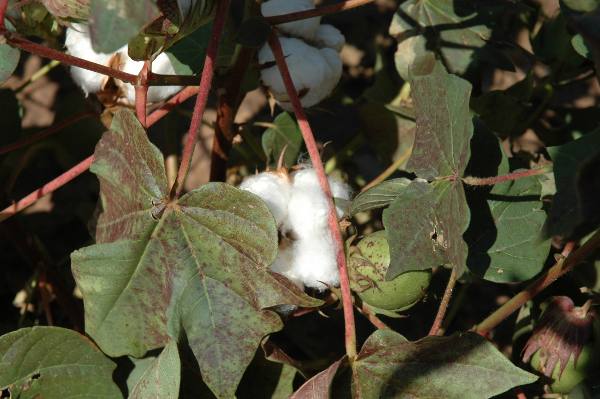March 18, 2013

Growers considering a shift from cotton to sorghum should put the pencil to it once more. With futures prices steadily over 80 cents per pound and early gin contracts offering nice premiums, irrigated cotton could mean $200 or more in return per acre.
In analyzing crop budgets for irrigated cotton and sorghum, the fiber crop again has strong profit potential, says Jackie Smith, Texas AgriLife Extension cotton marketing specialist in Lubbock.
“We want growers to look at their numbers and determine which crop may work best for their individual situations,” Smith says. “The ratio of the cotton price compared to the sorghum price has changed the last few months. Cotton has gradually moved up some and corn and sorghum prices have moved down.”
Sorghum is certainly a major crop for much of Texas. It’s often a savior catch crop if cotton is hailed out. But with higher grain prices in recent years, milo has been more popular as a replacement for cotton and one that can handle drier condition better than corn.
That was when cotton stayed near 70 cents, compared to corn and sorghum prices well over $7 a bushel and $13-plus per hundredweight. However, good rains in the Midwest have some analysts forecasting a normal corn year, which will likely send grain prices lower.
Of course, all bets are off if the drought of 2011 and 2012 picks up where it left off. Even growers with sufficient irrigation need a little help from the skies. And anywhere toward normal rainfall could help produce strong yields from cotton or sorghum, Smith says.
Revisit Your Budgets
It gets down to market prices for both commodities versus your cost of production. Smith and colleague Jay Yates have written sample budget projections for producing 1,250-pound irrigated cotton and 5,500-pound irrigated sorghum.
The cotton numbers were based on a price of 71 cents a pound. The milo numbers were based on $9.20 a hundredweight. With those prices, cotton would return about $220 per acre. Sorghum would lose about $32 per acre. Sorghum would have to sell for $13.80 “to make the net returns the same as cotton,” Smith says.
All farm budgets will vary. But the AgriLife examples should be close to many on the southern plains for irrigated cotton and milo. For example, the budget for pivot irrigated cotton figures direct expenses at about $707 per acre. That includes per acre seed/technology fee costs of about $73, fertilizer costs at about $109, stripper harvesting at $100, ginning $129 and irrigation fuel at about $108. Fixed expenses are about $194 per acre, including $75 in land costs.
Total expenses are about $901. Gross return is $1,121 per acre, including about $887 per acre from 1,250-pound., 71-cent-cotton and seed value of about $234. Net return is about $220 ($1,121 minus $901).
For sorghum, direct expenses are about $344 per acre, including about $96 in fertilizer costs, $81 for irrigation fuel and $33 for harvesting and hauling. Fixed expenses are the same $194.
Total expenses for sorghum are about $538. Gross return is about $506, based on 5,500 lb. per acre at $9.20 per hundredweight. That equates to the $32 loss per acre, again, according to the same AgriLife budgets.
In additional comparisons, 65-cent cotton would require $12.44 sorghum for an equal return. Cotton at 75 cents would require $14.71 sorghum. And 80-cent cotton would require about $15.85 sorghum, Smith says.
Smith says growers should consider contracts being offered by local or regional gins or grain elevators to make sure whether to lean toward cotton or sorghum. “Your yields and costs will not likely be the same as what I used in these projections,” he says.
“When it’s a close call (on which crop to plant), you may decide to spread your risk with diversification. And even if it’s close to the same returns, there may be credit reasons involved in your final decision.
“Your ag lender’s preference or your insurance guarantees likely will be important factors.”
Other factors to consider are Actual Production History (APH) versus trend yields, or disease problems, which may call for crop rotation.
Larry Nelson, CEO of Edmonson-based Windstar Gin, Inc., which has a network of six gins, says with a stronger cotton futures market, farmers can lock in a good price on part of their production. “We are offering a modified-acre contract that is 500 points off the December futures price,” he says.
“A grower can contract 50 percent of his APH now, then another 25 percent in August if he wants. And his basis is already locked in. With the futures prices we’ve seen, there is some good profit potential.”
In mid-March, for example, December futures hit 87 cents. With the modified-acre contract a grower could basically capture that entire price, Nelson says. “Even by deducting the 500 points or 5 cents, a 2½-cent selling charge and $3 per bale for the cotton checkoff, the grower can still pocket virtually the entire futures contract price because we will pay him $50 per bale for his seed,” he says.
Higher futures prices should have growers looking at contracts, Smith says. Unlike some forecasters, he isn’t as confident in higher prices ahead. “I’m not real bullish on the market going up much more,” he says. “I would think that if irrigated producers get a chance to contract irrigated production in the upper 70s, I would sure do it.
“I may not say that about dryland. There is still too much production risk with the lingering drought.”
To compare the AgriLife sample budgets to yours, go to http://agrilife.org/southplainsprofit/ and download profitability spreadsheets.
If you are enjoying reading this article, please check out Southwest Farm Press Daily and receive the latest news right to your inbox.
You may also like:
Cotton acreage still up in the air but prospects improved
Crop insurance and conservation compliance
South Texas farmers face tough decision as deadline approaches
About the Author(s)
You May Also Like




